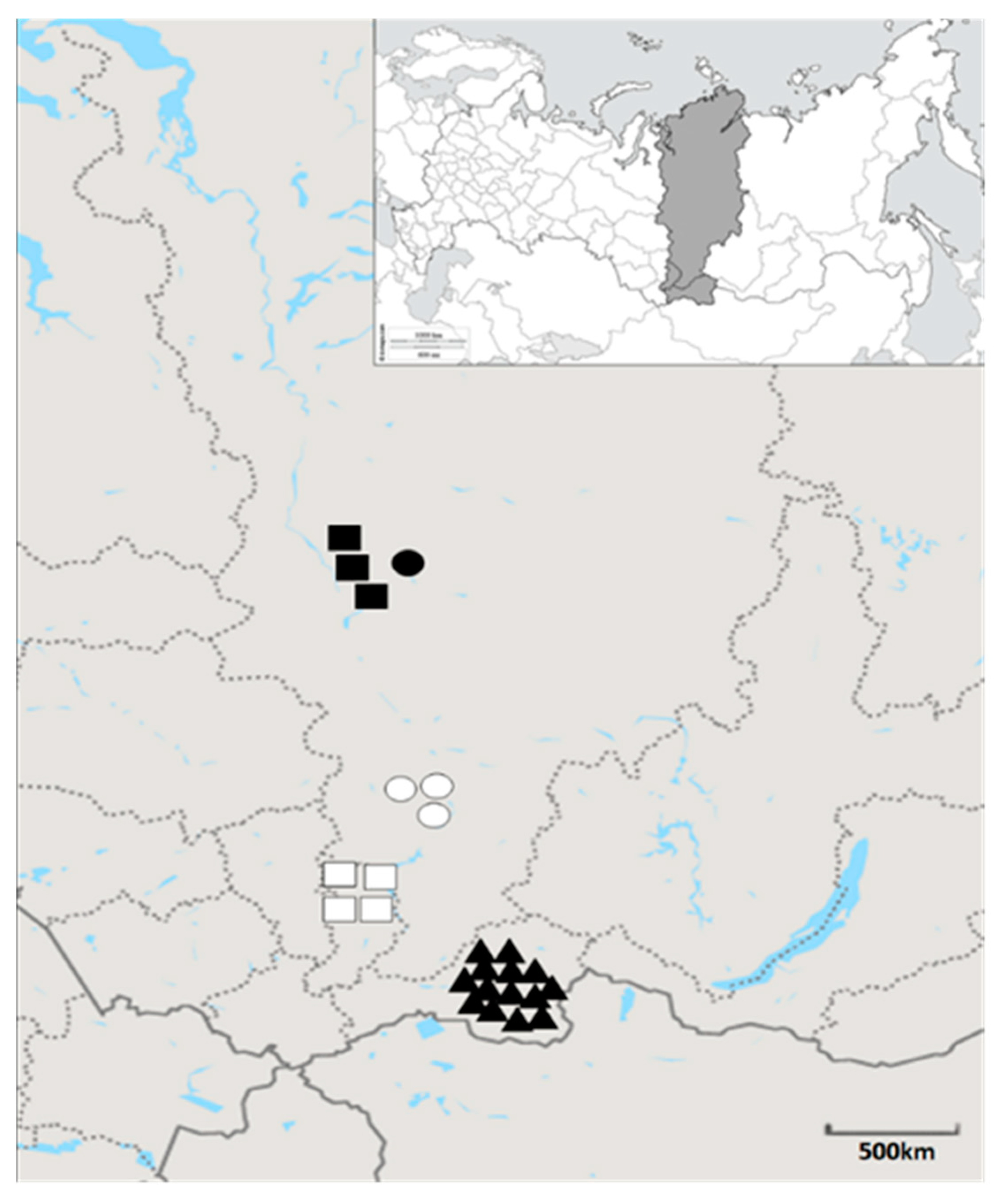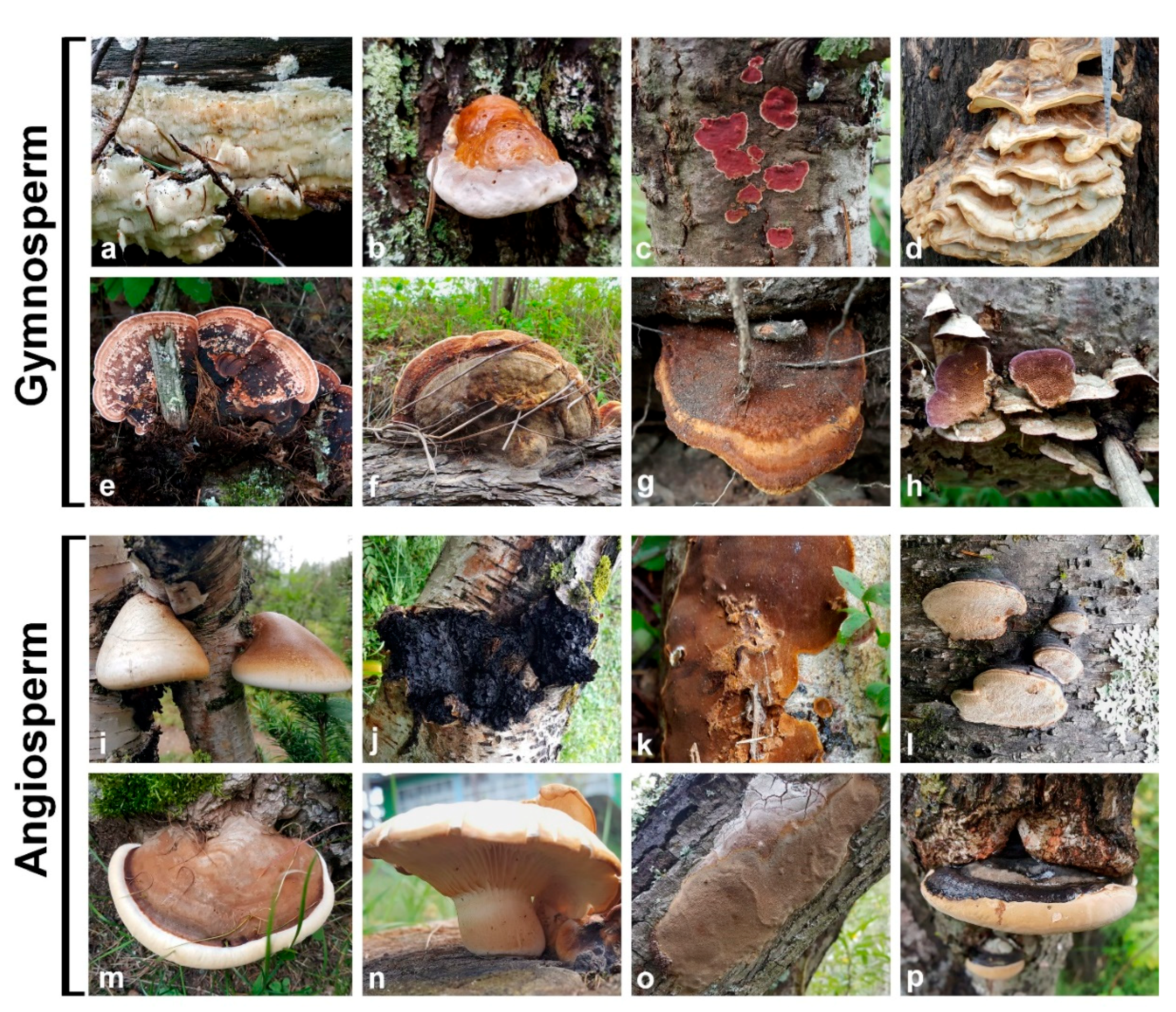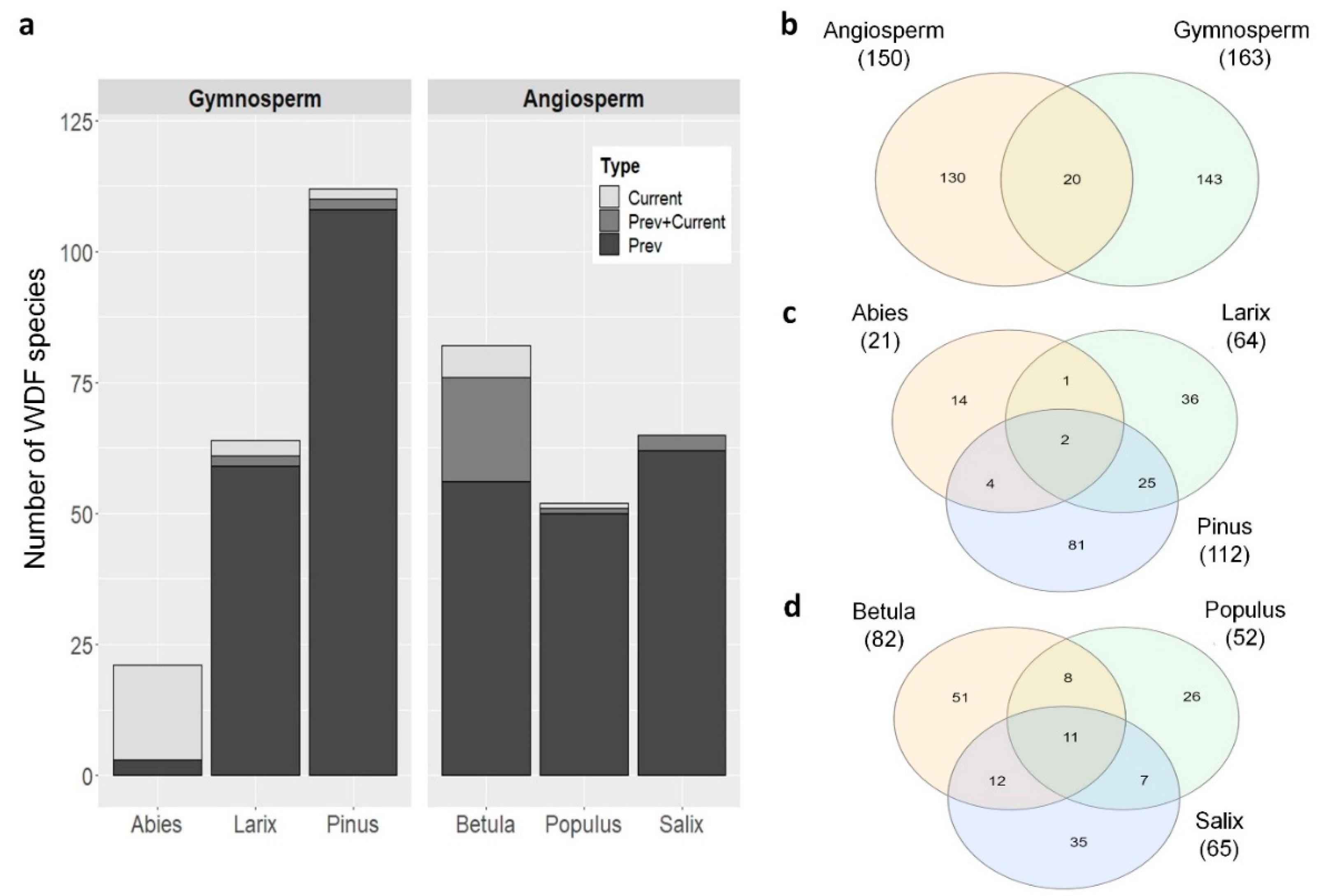Investigating Wood Decaying Fungi Diversity in Central Siberia, Russia Using ITS Sequence Analysis and Interaction with Host Trees
Abstract
1. Introduction
2. Materials and Methods
2.1. Sampling Sites and Determining the Major Wood-Decaying Fungi
2.2. Morphological and Molecular Approaches to WDF Identification
3. Results
3.1. WDF Identification
3.2. Host Preference
4. Discussion
Supplementary Materials
Author Contributions
Funding
Conflicts of Interest
References
- Harley, J.L. Fungi in ecosystems. J. Ecol. 1971, 59, 653–668. [Google Scholar] [CrossRef]
- Gilbertson, R.L. Wood-rotting fungi of North America. Mycologia 1980, 72, 1–49. [Google Scholar] [CrossRef]
- Deacon, J. Fungal Biology, 4th ed.; Wiley-Blackwell Publishing: Hoboken, NJ, USA, 2005; p. 384. ISBN 978-140-513-066-0. [Google Scholar]
- Lonsdale, D.; Pautasso, M.; Holdenrieder, O. Wood-decaying fungi in the forest: Conservation needs and management options. Eur. J. For. Res. 2008, 127, 1–22. [Google Scholar] [CrossRef]
- Ryvarden, L.; Johansen, I. A Preliminary Polypore Flora of East Africa; Fungiflora: Oslo, Norway, 1980; p. 636. ISBN 978-094-534-514-5. [Google Scholar]
- Lundell, T.K.; Mäkelä, M.R.; de Vries, R.P.; Hildén, K.S. Genomic, lifestyles and future prospects of wood-decay and litter-decomposing Basidiomycota. Adv. Bot. Res. 2014, 70, 329–370. [Google Scholar] [CrossRef]
- Miller, S.L.; McClean, T.M.; Walker, J.F.; Buyck, B.A. Molecular phylogeny of the Russulales including agaricoid, gasteroid and pleurotoid taxa. Mycologia 2001, 93, 344–354. [Google Scholar] [CrossRef]
- Wagner, T.; Fischer, M. Classification and phylogenetic relationships of Hymenochaete and allied genera of the Hymenochaetales, inferred from rDNA sequence data and nuclear behavior of vegetation mycelium. Mycol. Prog. 2002, 1, 93–104. [Google Scholar] [CrossRef]
- Mukhortova, L.; Schepaschenko, D.; Shvidenko, A.; McCallumm, I.; Kraxner, F. Soil contribution to carbon budget of Russian forests. Agric. For. Meteorol. 2015, 200, 97–108. [Google Scholar] [CrossRef]
- Venevsky, S.; Venevskaia, I. Hierarchical systematic conservation planning at the national level: Identifying national biodiversity hotspots using abiotic factors in Russia. Biol. Conserv. 2005, 124, 235–251. [Google Scholar] [CrossRef]
- Kamp, J.; Reinhard, A.; Frenzel, M.; Kämpfer, S.; Trappe, J.; Hölzel, N. Farmland bird responses to land abandonment in Western Siberia. Agric. Ecosyst. Environ. 2018, 268, 61–69. [Google Scholar] [CrossRef]
- Wu, C.; Wang, M.; Lu, C.; Venevsky, S.; Sorokina, V.; Kulygin, V.; Berdnikov, S. Climate-induced fire regimes in the Russian biodiversity hotspots. Glob. Ecol. Conserv. 2018, 16, e00495. [Google Scholar] [CrossRef]
- Mukhin, V.A.; Kotiranta, H. Wood-decaying fungi of northernmost forests in river Khatanga basin. Mikologiâ i Fitopatologiâ 2001, 35, 41–47. [Google Scholar]
- Ezhov, O.N.; Zmitrovich, I.V. Checklist of aphyllophoroid fungi (Agaricomycetes, Basidiomycota) in boreal forests of Pinega Reserve, north-east European Russia. Check List 2015, 11, 1495. [Google Scholar] [CrossRef]
- Kotiranta, H.; Shiryaev, A.G.; Spirin, V. Aphyllophoroid fungi (Basidiomycota) of Tuva Republic, Southern Siberia, Russia. Folia Cryptogam. Est. 2016, 53, 51–64. [Google Scholar] [CrossRef]
- Ezhov, O.; Zmitrovich, I.; Ruokolainen, A. Checklist of aphyllophoroid fungi (Agaricomycetes, Basidiomycota) in boreal forests of the Solovetsky Archipelago (Arkhangelsk Region, European Russia). Check List 2017, 13, 789–803. [Google Scholar] [CrossRef]
- Kotiranta, H.; Mukhin, V.A.; Ushakova, N.; Dai, Y.C. Polypore (Aphyllophorales, Basidiomycetes) studies in Russia 1. South Ural. Ann. Bot. Fenn. 2005, 42, 427–451. [Google Scholar]
- Kotiranta, H.; Ushakova, N.; Mukhin, V.A. Polypore (Aphyllophorales, Basidiomycetes) studies in Russia. 2. Central Ural. Ann. Bot. Fenn. 2007, 44, 103–127. [Google Scholar]
- Kotiranta, H.; Mukhin, V.A. Aphyllophorales (Basidiomycetes) of Tiksi, Republik of Sakha (Yakutia), Northeast Siberia. Karstenia 2000, 40, 65–69. [Google Scholar] [CrossRef]
- Parmasto, E. On the fungus-flora of kamtchatka. Issled. Prir. Daln. Vost. 1963, 1, 221–289. [Google Scholar]
- Kotiranta, H.; Mukhin, V.A. Polyporaceae and Corticiaceae of an isolated forest of Abies nephrolepis in Kamchatka, Russian Far East. Karstenia 1998, 38, 69–80. [Google Scholar] [CrossRef][Green Version]
- Kotiranta, H.; Shiryaev, A.G. Aphyllophoroid fungi (Basidiomycota) in Tunguska River basin, central East Siberia, Russia. Karstenia 2016, 55, 25–42. [Google Scholar] [CrossRef][Green Version]
- Shiryaev, A.G.; Kotiranta, H. Aphyllophoroid fungi (Basidiomycota) of the middle part of Yenisei River basin, East Siberia, Russia. Karstenia 2016, 55, 43–60. [Google Scholar] [CrossRef][Green Version]
- Jülich, W. Notes on Subulicystidium longisporum (Pat.) Parm. Int. J. Mycol. Lichenol. 1984, 1, 281–282. [Google Scholar]
- Ryvarden, L.; Gilbertson, R.L. European polypores vol. 1. In Synopsis Fungorum; Fungiflora: Oslo, Norway, 1993; Volume 6, pp. 1–387. [Google Scholar]
- Hansen, L.; Knudsen, H. Nordic Macromycetes. Vol. 3: Heterobasidioid, Aphyllophoroid and Gastromycetoid Basidiomycetes; Nordsvamp: Copenhagen, Denmark, 1997; p. 444. ISBN 978-879-839-611-6. [Google Scholar]
- Yang, Z.H.; Rannala, B. Bayesian species delimitation using multilocus sequence data. Proc. Natl. Acad. Sci. USA 2010, 107, 9264–9269. [Google Scholar] [CrossRef] [PubMed]
- Hebert, P.D.N.; Cywinska, A.; Ball, S.L.; de Waard, J.R. Biological identification through DNA barcodes. Proc. Biol. Sci. 2003, 270, 313–321. [Google Scholar] [CrossRef] [PubMed]
- Herr, J.R.; Öpik, M.; Hibbett, D. Towards the unification of sequenced-based classification and sequenced-based identification of host-associated microorganisms. New Phytol. 2015, 205, 27–31. [Google Scholar] [CrossRef] [PubMed]
- Hibbert, D.; Abarenkov, K.; Kõljalg, U.; Öpik, M.; Chai, B.; Cole, J.; Wang, Q.; Crous, P.; Robert, V.; Helgason, T.; et al. Sequence-based classification and identification of Fungi. Mycologia 2016, 108, 1049–1068. [Google Scholar] [CrossRef]
- Schoch, C.L.; Seifert, K.A.; Huhndorf, S.; Robert, V.; Spouge, J.L.; Levesque, C.A.; Chen, W.; Fungal Barcoding Consortium. Nuclear ribosomal internal transcribed spacer (ITS) region as a universal DNA barcode marker for Fungi. Proc. Natl. Acad. Sci. USA 2012, 9, 6241–6246. [Google Scholar] [CrossRef]
- Yamashita, S.; Hattori, T.; Abe, H. Host preference and species richness of wood-inhabiting aphyllophoraceous fungi in a cool temperature area of Japan. Mycologia 2012, 102, 11–19. [Google Scholar] [CrossRef]
- Nogueria-Melo, G.; Santos, P.J.; Gibertoni, T.B. Host-exclusivity and host-recurrence by wood decay fungi (Basidiomycota-Agaricomycetes) in Brazilian mangroves. Acta Bot. Bras. 2017, 31, 556–570. [Google Scholar] [CrossRef]
- Index Fungorum. Available online: www.indexfungorum.org (accessed on 27 February 2020).
- Rogers, S.O.; Bendich, A.J. Extraction of total cellular DNA from plants, algae and fungi. In Plant Molecular Biology Manual; Gelvin, S.B., Schilperoort, R.A., Eds.; Springer: Dordrecht, The Netherlands, 1994; pp. 183–190. [Google Scholar]
- White, T.J.; Bruns, T.; Lee, S.; Taylor, J.L. Amplification and direct sequencing of fungal ribosomal RNAgenes for phylogenetics. In PCR Protocols: A Guide to Methods and Applications; Academic Press: New York, NY, USA, 1990. [Google Scholar]
- Park, M.S.; Quan, Y.; Jung, P.E.; Oh, S.; Jang, Y.S.; Kim, J.; Lim, Y.W. Re-evaluation of the Genus Antrodia (Polyporales, Basidiomycota) in Korea. Mycobiology 2014, 42, 114–119. [Google Scholar] [CrossRef]
- Tamura, K.; Stecher, G.; Peterson, D.; Filipski, A.; Kumar, S. MEGA6: Molecular evolutionary genetics analysis version 6.0. Mol. Biol. Evol. 2013, 30, 2725–2729. [Google Scholar] [CrossRef] [PubMed]
- Czerepanov, S.K. Vascular Plants of Russia and Adjacent States (The Former USSR); Cambridge University Press: Cambridge, UK, 2007; p. 532. ISBN 978-052-145-006-5. [Google Scholar]
- Grand, E.A.; Hughes, K.W.; Petersen, R.H. Relationships within Lentinus subg. Lentinus (Polyporales, Agaricomycetes), with emphasis on sects. Lentinus and Tigrini. Mycol. Prog. 2011, 10, 399–413. [Google Scholar] [CrossRef]
- Gilbert, G.S.; Gorospe, J.; Ryvarden, L. Host and habitat preferences of polypore fungi Micronesian tropical flooded forests. Mycol. Res. 2008, 112, 674–680. [Google Scholar] [CrossRef] [PubMed]
- Krah, F.; Bässler, C.; Heibl, C.; Soghigian, J.; Schaefer, H.; Hibbet, D.S. Evolutionary dynamics of host specialization in wood-decay fungi. BMC Evol. Biol. 2018, 18, 119. [Google Scholar] [CrossRef]
- Gilbert, G.S. Evolutionary ecology of plant diseases in natural ecosystems. Annu. Rev. Phytopathol. 2002, 40, 13–43. [Google Scholar] [CrossRef]
- Hattori, T.; Yamashita, S.; Lee, S.U. Diversity and conservation of wood-inhabiting polylores and other aphyllophoraceous fungi in Malaysia. Biodivers. Conserv. 2012, 21, 2375–2396. [Google Scholar] [CrossRef]
- Tuor, U.; Winterhalter, K.; Fiechter, A. Enzymes of white-rot fungi involved in lignin degradation and ecological determinants for wood decay. J. Biotechnol. 1995, 41, 1–17. [Google Scholar] [CrossRef]
- Rypacek, V. Chemical composition of hemicelluloses as a factor participating in the substrate specificity of wood-destroying fungi. Wood Sci. Technol. 1977, 11, 59–67. [Google Scholar] [CrossRef]
- Simpson, J.A.; May, T.W. Phaeolus schweinitzii in Australia. Australas. Plant Pathol. 2002, 31, 99–100. [Google Scholar] [CrossRef]
- Asiegbu, F.O.; Adomas, A.; Stenlid, J. Conifer root and butt rot caused by Heterobasidion annosum (Fr.) Bref. sl. Mol. Plant Pathol. 2005, 6, 395–409. [Google Scholar] [CrossRef]
- Breitenbach, J.; Kränzlin, F. Fungi of Switzerland, Vol. 2; Verlag Mykologia: Lucerne, Swizerland, 1986; p. 412. ISBN 978-385-604-220-2. [Google Scholar]
- Gilbertson, R.L.; Ryvarden, L. North American Polypores 1; Fungiflora: Oslo, Norway, 1986; p. 443. ISBN 978-094-564-506-0. [Google Scholar]
- Dai, Y.C.; Wei, Y.L.; Zhang, X.Q. An annotated checklist of non-poroid Aphyllophorales in China. Ann. Bot. Fenn. 2004, 41, 233–247. [Google Scholar]
- Dai, Y.C. Polypore diversity in China with an annotated checklist of Chinese polypores. Mycoscience 2012, 53, 49–80. [Google Scholar] [CrossRef]
- O’Hanlon, R.; Harrington, T.J. Macrofungal diversity and ecology in four Irish forest types. Fungal Ecol. 2012, 5, 449–508. [Google Scholar] [CrossRef]
- Carranza-Morse, J.; Gilbertson, R.L. Cultural studies on the Fomitopsis rosea complex. Mycologia 1989, 81, 85–97. [Google Scholar] [CrossRef]
- Murrill, W.A. The polyporaceae of North America-VIII. Hapalopilus, Pycnoporus, and new monotypic genera. Bull. Torrey Bot. Club 1904, 31, 145–428. [Google Scholar]
- Han, M.L.; Chen, Y.Y.; Shen, L.L.; Song, J.; Vlasák, J.; Dai, Y.; Cui, B. Taxonomy and phylogeny of the brown-rot fungi: Fomitopsis and its related genera. Fungal Divers. 2016, 80, 343–373. [Google Scholar] [CrossRef]
- Tsuneda, I.; Kennedy, L.L. Basidiospore germination and substrate preference in Fomes fomentarius and Fomitopsis cajanderi. Mycologia 1980, 72, 204–208. [Google Scholar] [CrossRef]
- Cortesi, P.; Fischer, M.; Milgroom, M.G. Identification and spread of Fomitiporia punctate associated with wood decay of grapevine showing symptoms of Esca. Phytopathology 2000, 90, 967–972. [Google Scholar] [CrossRef]
- Fischer, M. Phellinus igniarius and its closest relatives in Europe. Mycol. Res. 1995, 99, 735–744. [Google Scholar] [CrossRef]
- Fischer, M. Grapevine wood decay and lignicolous basidiomycetes. Phytopathol. Mediterr. 2000, 39, 100–106. [Google Scholar]
- Berglund, H.; Edman, M.; Ericson, L. Temporal variation of wood-fungi diversity in boreal old-growth forests: Implications for monitoring. Ecol. Appl. 2005, 15, 970–982. [Google Scholar] [CrossRef]



| Fungal Species | Kr1 | Kr2 | Kr3 | Kh1 | Kh2 | Kh3 | Kh4 | Specimen No. (Acc No.) | Closest Match (Accession Number) | Similarity (%) |
|---|---|---|---|---|---|---|---|---|---|---|
| Antrodia gossypium (=Fibroporia gossypium) | Ab | Ab | SFC20170811-08 (MT044421) | Fibroporia gossypium (HM590880) | 100 | |||||
| Antrodia hingganensis | Ab | SFC20170811-04 (MT044428) | Antrodia hingganensis (KC595893) | 99.8 | ||||||
| Antrodia xantha | Ab | SFC20170811-17 (MT044427) | Antrodia xantha strain (DQ491424) | 100 | ||||||
| Botryobasidium subcoronatum | Be | Be | Be | SFC20170809-07 (MT044390) | Botryobasidium subcoronatum (AJ389790) | 100 | ||||
| Cerrena unicolor | Be | Be | SFC20140920-13 (MT044429) | Cerrena unicolor (KP135305) | 99.8 | |||||
| Climacodon pulcherrimus | Be | Be | SFC20170810-20 (MT044416) | Climacodon pulcherrimus (KY948784) | 99.8 | |||||
| Coniophora puteana | Ab | Ab | SFC20170809-26 (MT044400) | Coniophora puteana (AM293074) | 99.6 | |||||
| Daedaleopsis tricolor | Be | Be | Be | SFC20140920-08 (MT044430) | Daedaleopsis tricolor (MG696213) | 100 | ||||
| Fomes fomentarius | Be | Be | Be | Be | SFC20170809-15 (MT044396) | Fomes fomentarius (EF155499) | 100 | |||
| Fomitiporia punctata | Sa | Sa | SFC20140922-20 (MT044431) | Fomitiporia punctata (KX639630) | 99.6 | |||||
| Fomitopsis betulina (=Piptoporus betulinus) | Be | Be | Be | Be | SFC20170809-09 (MT044392) | Piptoporus betulinus (JX109856) | 99 | |||
| Fomitopsis pinicola | Ab | Pi | Be | Ab | SFC20140919-02 (MT044432) | Fomitopsis pinicola (KX524505) | 100 | |||
| Ganoderma applanatum | Po | Po | Be | Be | SFC20170809-27 (MT044401) | Ganoderma applanatum (KY364256) | 99.6 | |||
| Gloeocystidiellum convolvens (=Gloeopeniophorella convolvens) | Be | Be | SFC20140920-19 (MT044433) | Gloeopeniophorella convolvens (KY848506) | 99.8 | |||||
| Gloiothele sp. | Ab | Ab | SFC20170811-07 (MT044420) | Gloiothele sp. (KJ713991) | 99.6 | |||||
| Hapalopilus rutilans | Ab | Ab | Ab | SFC20170811-05 (MT044419) | Hapalopilus rutilans (KX752625) | 98.9 | ||||
| Hericium coralloides | Be | SFC20170810-04 (MT044405) | Hericium coralloides (MG735348) | 99.8 | ||||||
| Heterobasidion annosum | Ab | SFC20140922-17 (MT044434) | Heterobasidion annosum (MH859050) | 100 | ||||||
| Hymenochaete cruenta | Ab | Ab | SFC20170811-12 (MT044423) | Hymenochaete cruenta (JQ279595) | 100 | |||||
| Hypsizygus marmoreus | Po | SFC20170809-28 (MT044402) | Hypsizygus tessulatus (KP192620) | 100 | ||||||
| Inonotus leporinus | Ab | SFC20140919-04 (MT044435) | Inonotus leporinus voucher (FJ775542) | 99.5 | ||||||
| Inonotus obliquus | Be | Be | Be | SFC20140922-21 (MT044436) | Inonotus obliquus (KP004970) | 100 | ||||
| Irpex lacteus | Sa | Be | SFC20170810-15 (MT044413) | Irpex lacteus strain (JX311924) | 100 | |||||
| Kuehneromyces mutabilis | Ab | SFC20170809-25 (MT044399) | Kuehneromyces mutabilis (AY354218) | 100 | ||||||
| Laetiporus montanus | La | SFC20170809-01 (MT044387) | Laetiporus montanus (KX354466) | 99.8 | ||||||
| Neolentinus lepideus | Be | SFC20170810-14 (MT044412) | Neolentinus lepideus (HM536098.1) | 99.5 | ||||||
| Onnia tomentosa | La | SFC20170810-01 (MT044403) | Onnia tomentosa (KF996518) | 99.9 | ||||||
| Phaeolus schweinitzii | Ab | Pi | SFC20170810-18 (MT044415) | Phaeolus schweinitzii (FR686570) | 99.6 | |||||
| Phellinus igniarius | Sa | SFC20170809-03 (MT044388) | Phellinus igniarius (GQ383711) | 96 | ||||||
| Phellinus laricis (=Porodaedalea laricis) | La | Ab | SFC20170810-07 (MT044408) | Porodaedalea laricis (FJ775569) | 98.9 | |||||
| Phellinus cinereus | Be | SFC20170811-16 (MT044426) | Phellinus cinereus (AY340047) | 100 | ||||||
| Phellinus laevigatus | Be | Be | Be | SFC20170809-14 (MT044395) | Phellinus laevigatus (AY340053) | 100 | ||||
| Phellinus lundellii | Be | Be | Be | SFC20170811-03 (MT044418) | Phellinus lundellii (AY340058) | 100 | ||||
| Phlebia tremellosa | Be | Be | SFC20170809-08 (MT044391) | Phlebia tremellosa (LN611126) | 99.3 | |||||
| Pleurotus ostreatus (=Pleurotus pulmonarius) | Be | Be | Be | SFC20170810-10 (MT044410) | Pleurotus pulmonarius (KP867918) | 100 | ||||
| Plicaturopsis crispa | Be | Be | SFC20170811-10 (MT044422) | Plicaturopsis crispa (DQ494686) | 99 | |||||
| Postia balsamea | La | SFC20170810-11 (MT044411) | Postia balsamea (JF950570) | 99.1 | ||||||
| Postia caesiosimulans | Ab | SFC20170811-14 (MT044424) | Postia caesiosimulans (MG137061) | 99.2 | ||||||
| Postia fragilis | Ab | SFC20170809-23 (MT044398) | Postia fragilis (JF950573) | 99.6 | ||||||
| Postia lateritia | Ab | SFC20170811-15 (MT044425) | Postia lateritia (JF950566) | 97.6 | ||||||
| Postia sp. | Pi | SFC20140922-07 (MT044437) | Postia sp. (KJ668468) | 96.7 | ||||||
| Rhodofomes cajanderi (=Fomitopsis cajanderi) | La | La | SFC20170810-06 (MT044407) | Fomitopsis cajanderi (DQ491413) | 100 | |||||
| Stereum hirsutum | Be | Be | SFC20170809-10 (MT044393) | Stereum hirsutum (AY854063) | 99.8 | |||||
| Stereum subtomentosum | Be | Be | Be | SFC20140920-21 (MT044438) | Stereum subtomentosum ( KR673461) | 98.5 | ||||
| Trametes hirsuta | Be | Be | SFC20170810-16 (MT044414) | Trametes hirsuta (KF573009) | 99.6 | |||||
| Trametes pubescens | Be | SFC20170810-09 (MT044409) | Trametes pubescens (JN164960) | 99.3 | ||||||
| Trametes versicolor | Be | Be | SFC20170809-05 (MT044389) | Trametes versicolor (JN164965) | 99.7 | |||||
| Trichaptum abietinum | Ab | Pi | Pi | Ab | Ab | Ab | SFC20170809-22 (MT044397) | Trichaptum abietinum (AY781273) | 99.8 | |
| Trichaptum biforme | Be | Be | Be | SFC20170810-02 (MT044404) | Trichaptum biforme (MH245095) | 99.8 | ||||
| Vitreoporus dichrous (=Gloeoporus dichrous) | Be | Be | SFC20170810-21 (MT044417) | Gloeoporus dichrous (MG572751) | 100 | |||||
| Xylodon flaviporus | Be | SFC20170810-05 (MT044406) | Xylodon flaviporus (AF145585) | 100 | ||||||
| Xylodon radula | Ab | Ab | SFC20170809-11 (MT044394) | Xylodon radula (KP814413) | 99.5 | |||||
| The number of samples | 6 | 3 | 20 | 2 | 29 | 25 | 21 |
© 2020 by the authors. Licensee MDPI, Basel, Switzerland. This article is an open access article distributed under the terms and conditions of the Creative Commons Attribution (CC BY) license (http://creativecommons.org/licenses/by/4.0/).
Share and Cite
Park, J.-H.; Pavlov, I.N.; Kim, M.-J.; Park, M.S.; Oh, S.-Y.; Park, K.H.; Fong, J.J.; Lim, Y.W. Investigating Wood Decaying Fungi Diversity in Central Siberia, Russia Using ITS Sequence Analysis and Interaction with Host Trees. Sustainability 2020, 12, 2535. https://doi.org/10.3390/su12062535
Park J-H, Pavlov IN, Kim M-J, Park MS, Oh S-Y, Park KH, Fong JJ, Lim YW. Investigating Wood Decaying Fungi Diversity in Central Siberia, Russia Using ITS Sequence Analysis and Interaction with Host Trees. Sustainability. 2020; 12(6):2535. https://doi.org/10.3390/su12062535
Chicago/Turabian StylePark, Ji-Hyun, Igor N. Pavlov, Min-Ji Kim, Myung Soo Park, Seung-Yoon Oh, Ki Hyeong Park, Jonathan J. Fong, and Young Woon Lim. 2020. "Investigating Wood Decaying Fungi Diversity in Central Siberia, Russia Using ITS Sequence Analysis and Interaction with Host Trees" Sustainability 12, no. 6: 2535. https://doi.org/10.3390/su12062535
APA StylePark, J.-H., Pavlov, I. N., Kim, M.-J., Park, M. S., Oh, S.-Y., Park, K. H., Fong, J. J., & Lim, Y. W. (2020). Investigating Wood Decaying Fungi Diversity in Central Siberia, Russia Using ITS Sequence Analysis and Interaction with Host Trees. Sustainability, 12(6), 2535. https://doi.org/10.3390/su12062535






